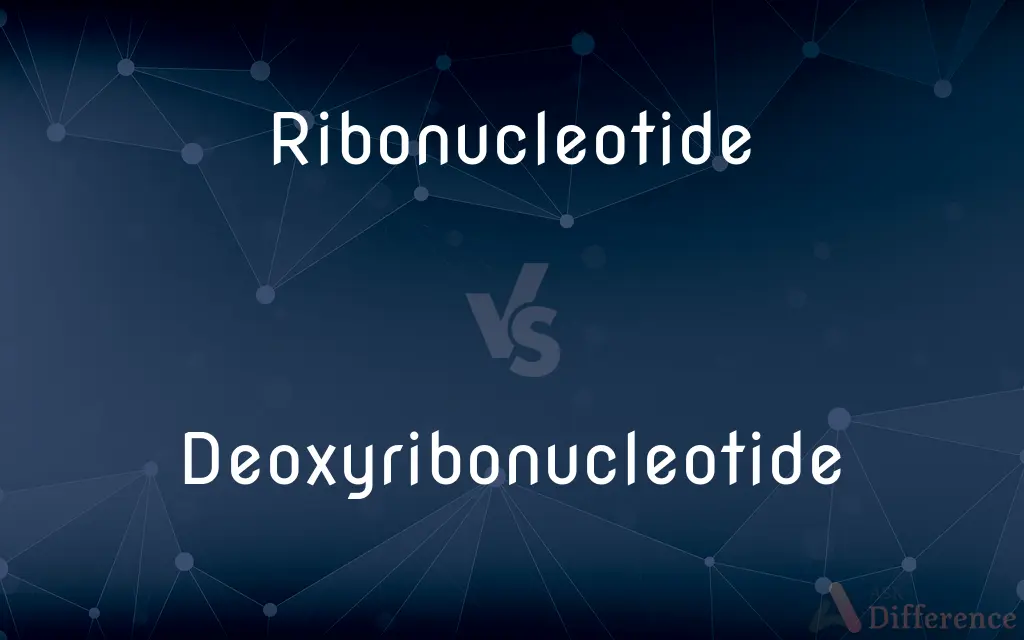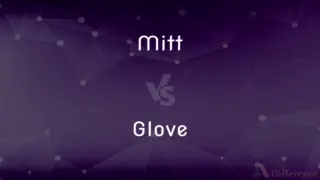Ribonucleotide vs. Deoxyribonucleotide — What's the Difference?
Edited by Tayyaba Rehman — By Urooj Arif — Updated on April 16, 2024
Ribonucleotides are the monomers of RNA, containing ribose sugars, while deoxyribonucleotides form DNA and feature deoxyribose, a sugar lacking one oxygen atom.

Difference Between Ribonucleotide and Deoxyribonucleotide
Table of Contents
ADVERTISEMENT
Key Differences
Ribonucleotides form the basic building blocks of ribonucleic acid (RNA) and include a ribose sugar, a phosphate group, and one of four nitrogenous bases: adenine, guanine, cytosine, or uracil. In contrast, deoxyribonucleotides are the monomers of deoxyribonucleic acid (DNA) and consist of a deoxyribose sugar, a phosphate group, and one of four bases: adenine, guanine, cytosine, or thymine.
The key difference in the sugar component—ribose in ribonucleotides and deoxyribose in deoxyribonucleotides—is that ribose has an additional oxygen atom present at the 2' carbon of the sugar ring. On the other hand, this oxygen is absent in deoxyribose, giving DNA its name ('deoxy' indicating the lack of oxygen).
This structural difference influences the stability and functionality of the nucleic acids formed. RNA, made of ribonucleotides, is typically single-stranded and more reactive due to the presence of the hydroxyl group on the ribose, which makes it less stable but more flexible. Whereas DNA, composed of deoxyribonucleotides, is more stable and typically exists as a double-stranded helix, suitable for long-term storage of genetic information.
In terms of function, ribonucleotides are involved in various roles such as coding, decoding, regulation, and expression of genes. They are crucial in processes like mRNA synthesis and the regulation of these processes. Deoxyribonucleotides, however, primarily serve in storing and transmitting genetic material from one generation to the next.
In biochemical synthesis, both types of nucleotides are synthesized differently in cells. Ribonucleotide reductase enzyme converts ribonucleotides to deoxyribonucleotides, which is a key step in the formation of DNA from RNA precursors.
ADVERTISEMENT
Comparison Chart
Sugar Type
Ribose
Deoxyribose
Oxygen at 2' Carbon
Present
Absent
Nitrogenous Bases
Adenine, Guanine, Cytosine, Uracil
Adenine, Guanine, Cytosine, Thymine
Stability
Less stable, more reactive
More stable, less reactive
Function
Protein synthesis, gene regulation
Genetic information storage
Compare with Definitions
Ribonucleotide
Contains one of the bases adenine, guanine, cytosine, or uracil.
Uracil is a base exclusive to ribonucleotides in RNA.
Deoxyribonucleotide
The building blocks of DNA, featuring deoxyribose.
Deoxyribonucleotides provide the structural backbone for DNA.
Ribonucleotide
The building blocks of RNA, consisting of a ribose sugar.
Ribonucleotides are crucial for synthesizing mRNA in the cell.
Deoxyribonucleotide
Includes thymine instead of uracil, which pairs with adenine.
Thymine stabilizes DNA structure with its double ring system.
Ribonucleotide
Involved in immediate cellular processes like protein synthesis.
Ribonucleotides quickly form RNA strands needed for protein construction.
Deoxyribonucleotide
Designed for stability and long-term storage of genetic information.
The lack of a hydroxyl group in deoxyribonucleotides enhances DNA stability.
Ribonucleotide
More susceptible to hydrolysis due to the extra oxygen molecule.
The hydroxyl group in ribonucleotides contributes to the overall instability of RNA.
Deoxyribonucleotide
Central to inheritance and genetic information transfer.
Mutations in the sequence of deoxyribonucleotides can lead to genetic disorders.
Ribonucleotide
Forms through pathways that differ slightly from those of deoxyribonucleotides.
Ribonucleotide levels must be carefully regulated to maintain cellular balance.
Deoxyribonucleotide
Synthesized from ribonucleotides by ribonucleotide reductase.
The enzyme ribonucleotide reductase is essential for DNA replication.
Ribonucleotide
In biochemistry, a ribonucleotide is a nucleotide containing ribose as its pentose component. It is considered a molecular precursor of nucleic acids.
Deoxyribonucleotide
A deoxyribonucleotide is a nucleotide that contains deoxyribose. They are the monomeric units of the informational biopolymer, deoxyribonucleic acid (DNA).
Ribonucleotide
A nucleotide that contains ribose as its sugar and is a component of RNA.
Deoxyribonucleotide
A nucleotide that contains deoxyribose as its sugar and is a constituent of DNA.
Ribonucleotide
Any nucleotide having ribose as its sugar
Deoxyribonucleotide
Any nucleotide containing deoxyribose.
Deoxyribonucleotide
An organic molecule consisting of a hereocyclic base attached to the 1-carbon of a deoxyribose ring, with a phosphate group esterified at the 5 position of the deoxyribose. Deoxyribonuceotides are the monomer units which make up deoxyribonucleic acid, the molecule carrying the hereditary information in most organisms. The most common forms of deoxyribonuceotide are thymidine-5´-phosphate (abbreviated TMP), deoxyadenosine-5´-phosphate (abbreviated dAMP), deoxyguanosine-5´-phosphate (abbreviated dGMP), and deoxycytidine-5´-phosphate (abbreviated dCMP).
Common Curiosities
How do the bases in ribonucleotides and deoxyribonucleotides differ?
Ribonucleotides use uracil, while deoxyribonucleotides use thymine.
Why are deoxyribonucleotides more stable than ribonucleotides?
The absence of the hydroxyl group at the 2' carbon in deoxyribonucleotides reduces reactivity and increases DNA stability.
What are the functional differences between RNA and DNA?
RNA mainly functions in protein synthesis and gene regulation, while DNA is responsible for storing and transmitting genetic information.
Why does RNA use uracil and DNA use thymine?
Uracil in RNA makes it less stable and more suitable for temporary roles, while thymine in DNA helps ensure stability for long-term genetic storage.
Can ribonucleotides be converted to deoxyribonucleotides?
Yes, ribonucleotide reductase enzyme converts ribonucleotides to deoxyribonucleotides in cells.
What role do ribonucleotides play in cells?
They are involved in processes like transcription and regulation of gene expression.
What happens if there is a mutation in deoxyribonucleotides?
Mutations can lead to changes in the genetic code, potentially resulting in genetic disorders or diseases.
What is the significance of the 2' hydroxyl group in ribonucleotides?
The 2' hydroxyl group makes ribonucleotides more reactive and less stable, fitting for their role in RNA.
What is the structural difference between ribonucleotides and deoxyribonucleotides?
Ribonucleotides contain ribose sugar, while deoxyribonucleotides contain deoxyribose, which lacks an oxygen atom at the 2' carbon.
How are ribonucleotides and deoxyribonucleotides synthesized?
Ribonucleotides are synthesized from basic cellular nutrients, while deoxyribonucleotides are formed from ribonucleotides by enzymatic reduction.
Share Your Discovery

Previous Comparison
Editorial vs. Article
Next Comparison
Mitt vs. GloveAuthor Spotlight
Written by
Urooj ArifUrooj is a skilled content writer at Ask Difference, known for her exceptional ability to simplify complex topics into engaging and informative content. With a passion for research and a flair for clear, concise writing, she consistently delivers articles that resonate with our diverse audience.
Edited by
Tayyaba RehmanTayyaba Rehman is a distinguished writer, currently serving as a primary contributor to askdifference.com. As a researcher in semantics and etymology, Tayyaba's passion for the complexity of languages and their distinctions has found a perfect home on the platform. Tayyaba delves into the intricacies of language, distinguishing between commonly confused words and phrases, thereby providing clarity for readers worldwide.














































